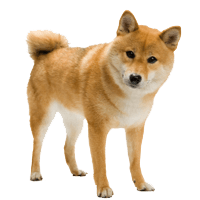
Avg Size of Female: Height: 13.5-15.5 inches, Weight: 20-30 pounds
Occasionally seen: None
Major concerns: None
LifeSpan: 12 – 15 years
Avg Size of Male: Height: 14.5-16.5 inches, Weight: 20-30 pounds
Minor concerns: Patellar luxation
Suggested tests: Knee
Brief History on Shiba Inu Origin
The Shiba Inu was actually not given the name “Shiba Inu” until the 1920s. The origin of the breed descended from spitz heritage. The fact that it could roam traverse steep hills and mountain regions that were not accessible to mankind, made it a superb and extremely useful hunting dog. This breed was initially used to rid birds and small game, although it was also occasionally used to hunt wild boar as well. After World War II, the breed diminished in numbers, and it was almost completely extinct due to distemper in 1952.
The remaining dogs from the three different varieties of shibas, the Shinshu shiba, the Mino shiba, and the Sanin shiba were all interbred to help repopulate the breed. An armed service family brought the first Shiba Inu to America 1954. Later down the line in the 1979, the first litter of Shibas was born in the United States. The Shiba Inu was not recognized by the AKC until 1993, and has a large following of supporters to this day.
Shiba Inu Breed Appearance
Showing off its Northern characteristics, it has small erect ears, dense fur, and a curled tail. The Shiba Inu is actually the smallest of all the Japanese dog breeds. Its expression truly reveals its personality, bold and friendly. The Shiba’s double coat is plush underneath with a coarse, straight outer coat. It is colored in red, black and tan, black, salt and pepper or white.
Shiba Inu Breed Temperament
The Shiba Inu will require consistent training due to its strong will. It is active and smart always prepared for an exciting adventure. The Shiba Inu can come off as aloof or uninterested with some people, but this breed truly loves to show affection to its family. This breed guards its territory and makes an excellent watchdog. It can bark excessively at times, and may also show some dominant or aggressive behavior towards dogs of the same sex. It will be relatively calm indoors if provided with proper exercise. Outdoors, it will be quite lively and its prey drive may urge it to chase small animals.
Shiba Inu Breed Maintenance
This breed should be brushed multiple times a week, more so when shedding. Since the double coat of the Shiba is naturally waterproof, it only needs a bath when absolutely necessary. This breed needs plenty of daily exercise to maintain its toned, lean form throughout life. Its daily workout should involve a fast-paced game in the yard, a moderate run to the park and back, or a long walk around the neighborhood. It will do well in an apartment as long as it receives plenty of exercise and mental stimulation. They can live outdoors in temperate to cool climates, however they prefer to be with their family so access to the home is recommended.
The Shiba Inu can be stubborn and should be trained with a positive yet firm method, they do not respond well with harsh treatment and will begin ignoring orders. Puppies should be trained and socialized often, simply to prevent aggression towards other animals. This breed is vocal, making for a great watchdog.
 Toledo, United States.
Toledo, United States.